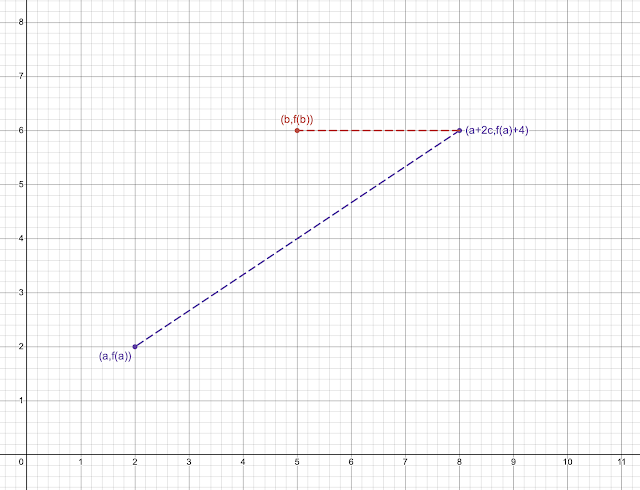Visualising FEs!
(Drew here.)
Three weeks ago, we had a post about visualising combi, and last week, it was about the anatomy of an FE. Out of sheer coincidence, here I am now talking about visualising FEs! A nice way to avoid the notoriously grindy nature of FEs and favour a combi main like me :)
Let's begin with a familiar one: Cauchy's functional equation.
(Positive real Cauchy) Find all $f:\mathbb R^+\to\mathbb R^+$ satisfying $f(x+y)=f(x)+f(y)$ for all $x,y\in\mathbb R^+$.
The solutions to this are $f(x)=cx$ for $c\in\mathbb R^+$, which are all linear functions.
For any integer $n$, we can calculate
$$\begin{align*}f(nx)&=f((n-1)x+x)\\&=f((n-1)x)+f(x)\\&=f((n-2)x)+f(x)+f(x)\\&=\dots\\&=\underbrace{f(x)+f(x)+\dots+f(x)}_n\\&=nf(x).\end{align*}$$
So given a rational number $r=\frac mn$ we have that \[f(rx)=f\left(\frac mnx\right)=mf\left(\frac xn\right)=\frac mnf\left(\frac xn\cdot n\right)=\frac mnf(x)=rf(x).\]
Now back to the main topic, let's graph this function.
Suppose $f(1)=c_1$ for some $c_1$, then $f(r)=c_1r$ for all rational $r$, which forms a (dotted) line.
What if $f(t)=c_2$ for some other $c_2\neq c_1$? We get two different lines on the graph.
 |
| Could the graph of $f$ have two lines like this? |
Let's not forget that we are working over $\mathbb R^+$ over here, so we can get inequalities like $f(x+y)-f(x)=f(y)>0$, or in other words $f$ is increasing. Pictorially, this means any point $(x,f(x))$ "bans" a rectangular region below or above it, those which would connect to form negative gradient.
However, any other line must intersect this banned region (check that there exists a rational number $r$ such that $(r,c_2r)$ lies in the region), so in fact it's impossible to have $c_2\neq c_1$. We conclude that $f(x)=c_1x$ for all $x$.
 |
| Black "banned" region intersects every other line. |
Let's take closer look at what this solution uses:
- It creates a lot of points from one "seed". In this case, all the rational multiples of $x$ have their values known. Later we will see more complicated things that seeds can generate!
- Inequalities are used to create a "banned region". This is quite important to determine the shape of the graph.
In fact, with (2), we can look at another solution to finish the above: consider the union of banned regions generated by every point $(r,f(r))$!
The banned regions sweep out the entire quarter-plane, leaving only the points on the line $c_1x$ unbanned. (Again, one must write up the details of this slightly more carefully.)
 |
| No line may pass! |
Moving on to the next example:
(MOP '24 HW) Find all $f:\mathbb R\to\mathbb R$ satisfying $f(x^2)=f(x)^2$ and $f(x+1)=f(x)+1$ for all real numbers $x$.
The solution we're looking for here is $f(x)=x$.
First, let's eliminate some banned region: $f(x)=f\big(\sqrt x\big)^2\geq0$ for all $x\geq0$, banning the 4th quadrant.
Then, using the second condition we can translate any seed point $(x,f(x))$ to $(x+n,f(x)+n)$ for any integer $n$, and this may not land in the banned region either.
 |
| "Banned" staircase region. |
Now there seems to be this empty region below the line $y=x$, so let's settle that. Shift to a seed point $(s,f(s))$ where $1<s<2$ and repeatedly apply the first operation with $x=s$, $x=s^2$ etc.
This creates a number of points lying on the curve $y=x^{\log_s{f(s)}}$ (verify this!), where the exponent is less than 1. But the $x$ coordinate is unbounded, while the curve eventually nestles in the banned region, so this is impossible.
 |
| They trespass into the forbidden region! |
The upper half of the first quadrant is now easily handled by finding a corresponding negative point that lies under the line $y=x$.
 |
| Flip it downstairs! Or maybe downhill, since the stairs are gone now. |
So $f(x)=x$ for all $x>0$, and translation with the second condition gives the only solution $f(x)=x$.
(For the record, this solution allowed me to headsolve the problem in the plane! Also, this has been called a "homophonic" FE, because the LHS and RHS both sound the same when read out, making it nontrivial to communicate the statement.)
Again, the two things are present: the seed points and banned regions have great synergy with each other.
Finally, let's conclude with a problem from the USAMO last year:
(USAMO 2023/2) Find all functions $f:\mathbb R^+\to\mathbb R^+$ satisfying $f(xy+f(x))=xf(y)+2$ for all $x,y\in\mathbb R^+$.
We begin with some classic FE techniques:
- The solution is $f(x)=x+1$ only.
- By substituting $x=1$, we get $f(y+c)=f(y)+2$ where $c=f(1)$.
- For injectivity, if $f(a)=f(b)$, then $$af(b)+2=f(ab+f(a))=f(ab+f(b))=bf(a)+2=bf(b)+2$$ so $a=b$.
- We can also prove surjectivity to $(2,\infty)$, by making the substitution $x=\frac{t-2}{c}$ and $y=1$, making $t=f(...)$ for any $t>2$.
 | |
|
 |
| Starting to look linear? |
Formally, we can show that $\frac2cx-2\leq f(x)\leq\frac2cx+4$. In other words, the graph is bounded by the two red lines in the diagram above.
I really enjoy coming up with solutions like these, because they're less heavy on "FE trickery" and run-of-the-mill techniques, and showcase a unique perspective in FEs! Some other problems that feature graphical ideas / solutions are USAMO 2000/1, IMO 2013/5, and USA TST 2021/3, so if you reallyloveFEs, go try them out!
(Oh, and here's the Desmos link!)




Shoutouts to Celestia (another combi main :>) for introducing me to this idea and recommending all 3 of the problems at the end! :D
ReplyDelete